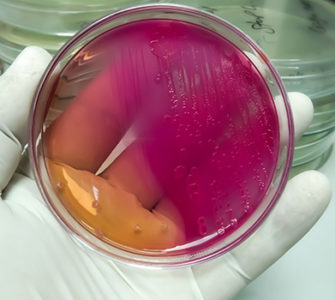Frequent Application of Litter Amendments in Broiler Houses During Grow-out on Bird Health, Production and Environment
A series of experiments at the University of Delaware show that frequent application of sodium bisulphate improved broiler production performance and foot pad quality and reduced ammonia emissions and Salmonella counts.
For the broiler industry, concerns about ammonia (NH3) emission are multifaceted and include issues of live production performance, animal health, welfare, environmental impact and public perception, according to Hong Li and colleagues at the University of Delaware.
Effectively managing ammonia emissions is critical to meeting foreseeable regulatory limits. Further research by industry and academia is needed to develop methods to manage and reduce ammonia emission.
Litter amendments have shown promise as a cost-effective and viable technology to reduce ammonia emission; however, the application of litter amendments has been limited to the few days before birds’ placements due to health and safety concerns related to acid materials.
Further research is needed to assess the feasibility and impact of frequent applications of litter amendments on ammonia volatilisation, production performance, microbial environments, bird health and food safety.
An innovative automated aerial application system has been developed to deliver and apply litter amendment products to the whole house with birds in the house.
Before adoption of continuous litter amendments for commercial production conditions, assessment tests have to be conducted to document the impact of the techniques not only on ammonia emission but also on overall animal health, production performance and thus production economics.
The objectives of this study, sponsored by the US Poultry & Egg Association, were:
- to evaluate/screen the efficacy of litter amendments (sodium bisulphate (PLT®), biochar and zeolite) with continuous application at different rates on reduction of ammonia emission
- to determine continuous application requirements of the litter amendments that prove promising from evaluation tests, without compromising production performance and health of broilers raised in climate controlled chambers by simulating field conditions, and
- to conduct field verification tests and economic analyses on sodium bisulphate regarding production performance, litter quality, and air emission reduction efficacy over an extended period to address the seasonal effects.
A laboratory study was conducted to evaluate the impact of different litter amendments (PLT, zeolite and activated charcoal) and moisture levels on ammonia emission from boiler litter.
PLT showed a higher emission reduction rate than zeolite, and activated charcoal did not show a capability to reduce ammonia emission at all moisture levels.
Based on the small scale in the laboratory with live birds, field verification studies at a commercial site and a university research site were conducted with two different PLT application strategies.
At the commercial site, three consecutive flocks of broilers were reared to an age of six weeks. PLT was applied at 21 and 35 days of age at a rate of 244g per square metre (50lb per 1,000 square feet).
At the university research site, five consecutive flocks were raised to an age ranging from 52 to 59 days. During each grow-out, different rates, 122, 183, 244, 305 and 366g per square metre (25, 37.5, 50, 62.5, 75.0lb per 1,000 square metres), of PLT were used weekly at the ages of 21, 28, 35, 42 and 49 days.
The results show that repeated application of PLT led to significant reduction in ammonia emissions from broiler litter.
The magnitude of ammonia emission reduction increases with the application rate of PLT.
The emission reduction rates of frequent PLT application during grow-out varied from 0.08 to 0.22g ammonia per gram of PLT.
Frequent PLT application correlated with improved production performance and foot pad quality.
Effects of PLT on aerobic bacteria counts, coliform counts, yeasts and moulds were insignificant.
Li and colleagues also found that frequent PLT application does reduce the presence of Salmonella but not Campylobacter.
January 2015
Article courtesy of ThePoultrySite.com
Posted on January 28, 2015

















